The more badminton I play, the more I’ve become interested in badminton shoes as they make up a meaningful part of our ability to prevent injuries and play more.
There’s a major difference between common sports shoes and those made for badminton. Heck, even between badminton-specific shoes you’ll have wildly different experiences. I’ve been fortunate to test a bunch of them and noticed major differences between styles.
In this article, I’ll build the perfect badminton shoe out of parts of existing shoes I’ve tested. The style I’m aiming for balances support and all-around performance in the name of longevity. It’s intended for passionate adult players like me who want to avoid injuries.
This will be a fun one. Let’s dive in!
Table of Contents
The anatomy of a badminton shoe
Before getting into the nitty-gritty, allow me to highlight the areas I’ll be covering today. Badminton shoes have several different elements and I took the liberty of illustrating them for you below.
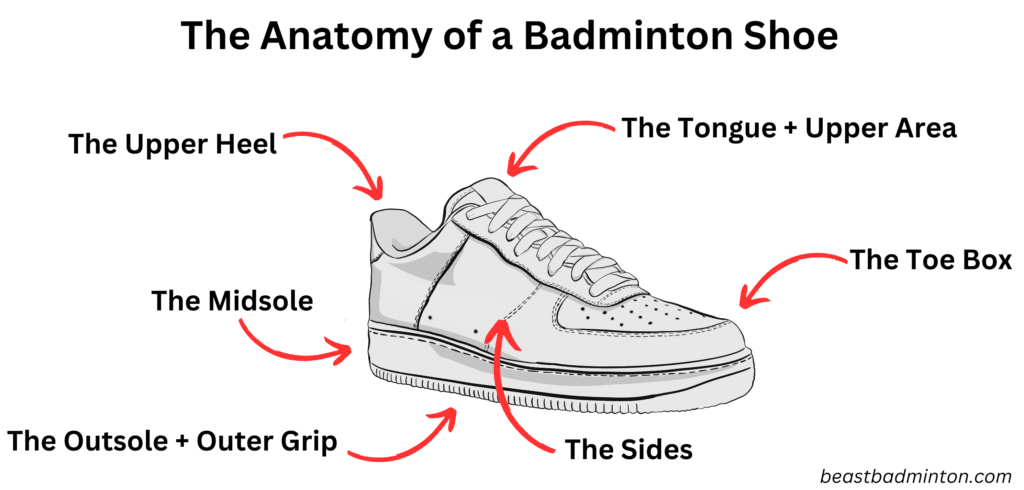
There are some natural conflicts such as how cushioning increases comfort, but also the weight of the shoe. It comes down to whether you prefer a lightweight shoe that feels more barebones or a heavier one with extra cushion, padding, and protection.
At the same time, you’ll run into issues like the more protection you add, the hotter the shoe becomes which can make things challenging if you play in hot weather.
If you’re looking for new shoes and are wondering which ones to consider for longevity, this article will give you ideas for choosing the right badminton shoe.
With that in mind, let’s look at what makes my perfect shoe.
When badminton shoes get it right
First, let’s look at the fit.
The snug fit
The weird thing about the fit of a shoe is that you’ll only think about it if it sucks. The better it is, the more natural it feels. Sometimes we can’t even recognize a shoe that fits well until we try something worse.
When I first tested the popular Yonex SHB 65z3, they felt amazing because I came from more affordable models. But after a while, I began noticing soreness on the side of my big toe and underneath after every two-hour social session on court.
At the time, I figured it was a common issue among players since that model was popular. But as I’ve tested more shoes I’ve discovered that this model just doesn’t fit my feet that well despite being the correct size and non-wide edition.
I tried many different things to fix it. Besides experimenting with normal plaster, sports plaster, and two pairs of socks, I even got two pairs of that same model in different sizes as I first thought that was the issue.
It was only when I tested different pairs and discovered Victor’s A970Ace that my feet truly felt at home when it came to the fit. You’d think it’s expected when switching to a more supportive and cushioned shoe… but this isn’t one. In fact, it competes directly with the Yonex 65z3 in the all-around category.
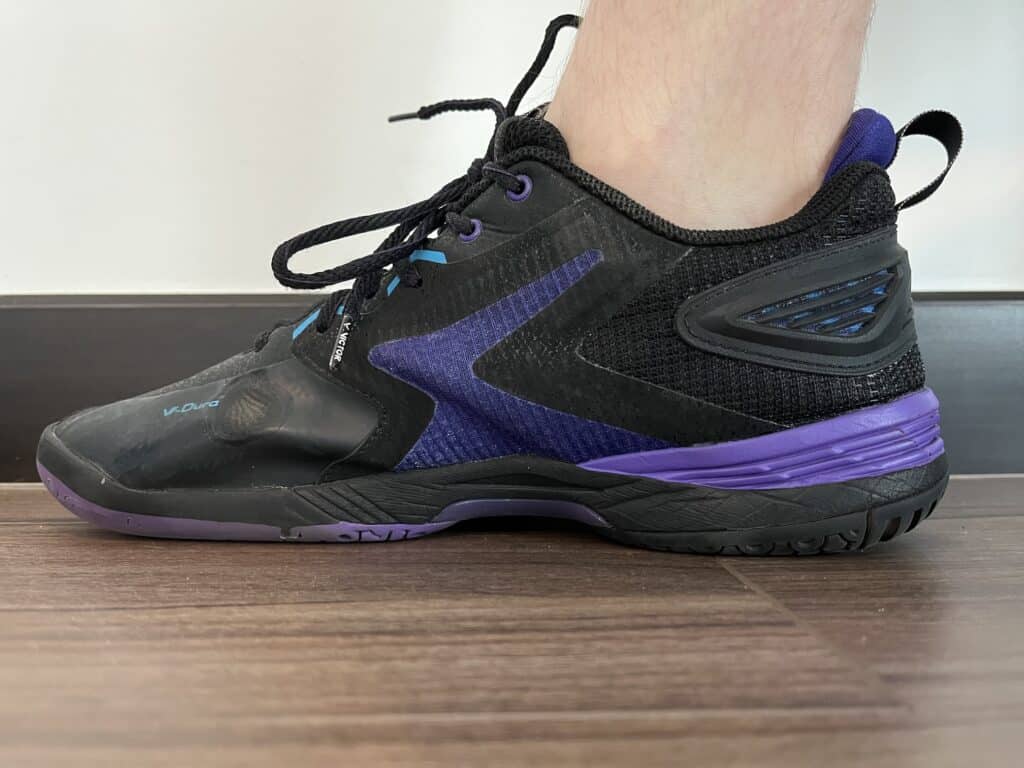
For my feet, it offers the best fit despite being an all-around model. It feels like some sort of natural bubble wrap around my feet while on court. If I had to pick a fit from all my tests, this is it.
Now, discussing the fit of a shoe is tricky as it’s made up of several smaller components throughout the shoe. Next, let’s dive deeper into each of those, starting with the upper heel.
The upper heel
I’ve noticed that the upper heel contributes a great deal to how your shoes feel to wear and the confidence they can give you during fast directional changes on court. Models with an upper heel lower than a certain point can feel as if you’re just about to slip up and out of the shoe all the time.
On the other hand, a taller and stiffer upper heel can give you confidence that this won’t happen while locking your ankle in ever so slightly that it’s harder to roll on either side and cause an ankle injury.
Surprisingly, an upper heel that’s too cushioned can feel too soft and give you the illusion that there’s room for your feet to move.
Despite disliking the look, my preferred choice here is also the upper heel from Victor’s A970Ace.
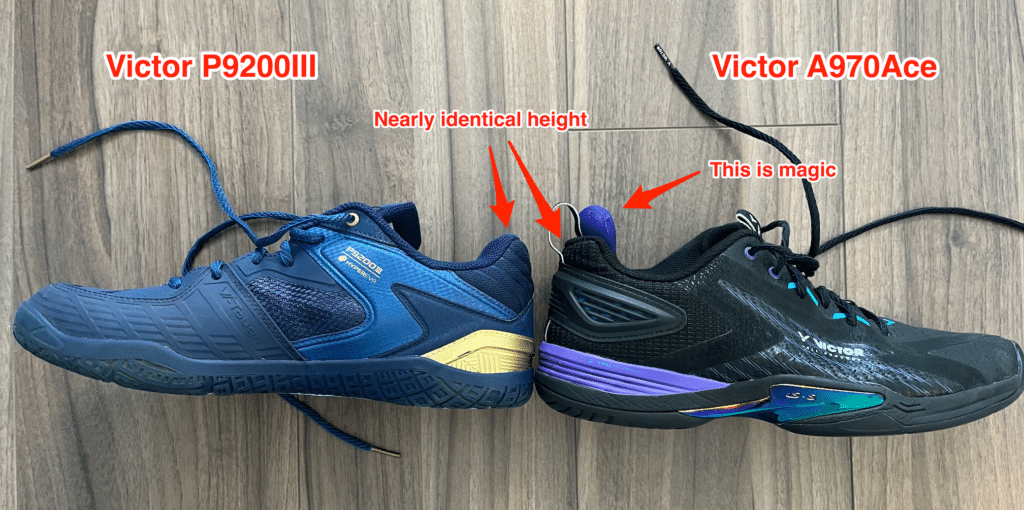

Those ugly heel pillows offer slight cushioning balanced with a mildly stiff feeling as if it keeps the shape and puts your heel in a comfortable lock.
Next, let’s look at the rest of the upper area and tongue.
The upper area + tongue
The shoe’s tongue impacts how comfortable and tight you can tie the shoelaces to tweak the fit to your preferences. Some tongues are thick and cushioned allowing you to tie the shoelaces extra tight without it hurting, but that can also feel as if the shoelaces can’t be tied tight enough and will go loose easily.

In my experience with a few pairs that are this way, it’s mostly an illusion. But even so, it gives the feeling that your shoes aren’t tied well enough, which can make you feel less confident throughout your games.
On the other hand, the top bit near the first hole for the shoelace feels sharp on models like Yonex’s Comfort Z3 and it can almost feel as if it cuts into your skin if you tie them tight.
As I was testing Yonex’s Eclipsion Z3, I found that it has a good balance between managing those two issues while offering a fit that locks in your feet in a good way.
The ventilating sides
The sides of the shoe contribute to a snug fit too, but feels like an afterthought if the upper heel and tongue area are on point. Where they can help, though, is with air ventilation so your feet feel less hot.
None of the shoes I’ve tested in the all-around category felt crazy hot, so this is only important in bulkier and more supportive models. Here, I prefer the thin sides from Yonex’s Comfort Z3, which is marketed as a blend between comfort and all-around, but on the more cushioned side of things.
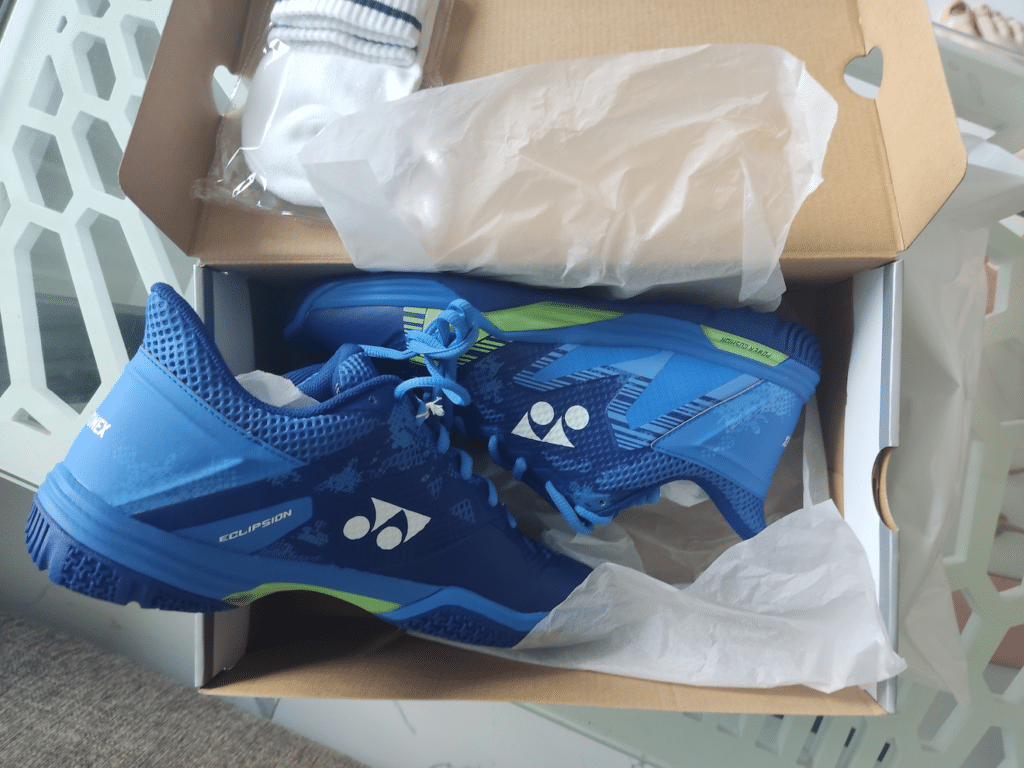
My second option is Li-Ning’s Yun Ting as they are bulkier and solve this issue through thin sides with ventilation holes.
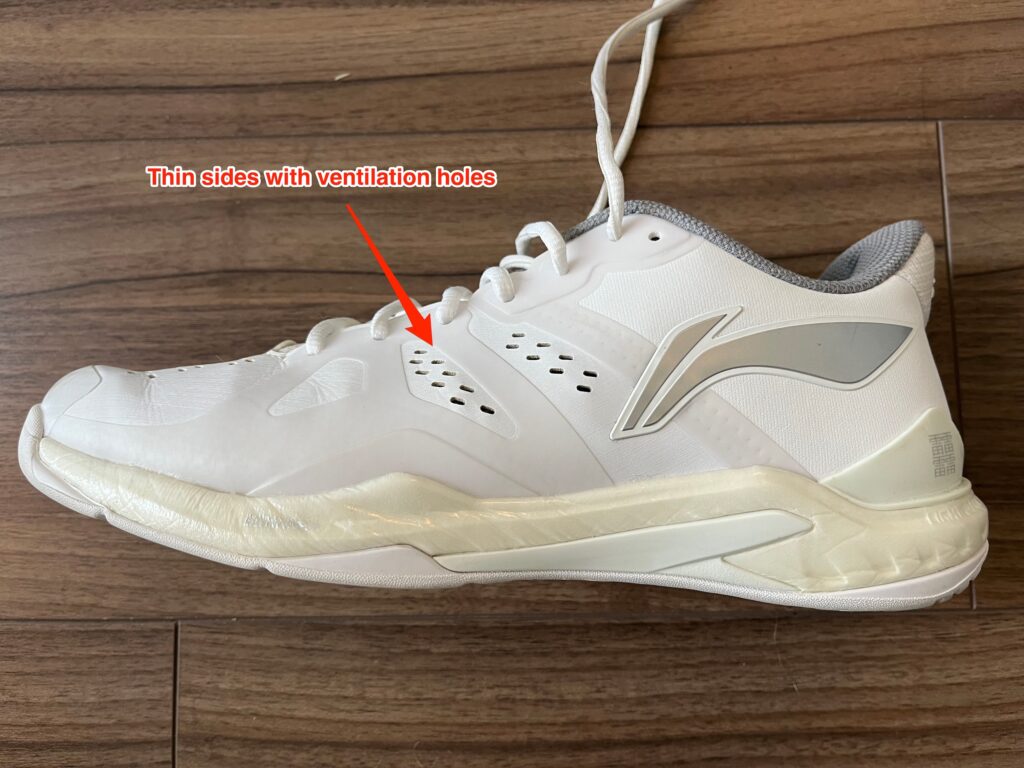
The air ventilation is especially useful to recover faster between games.
Next is one of the most noticeable items and the most important one to many players: protection from toe bumps against the front of the shoe during hard stops or deep lunges when retrieving frontcourt shots.
The toe box airbag
The toe box is tricky business as the midsole covers a part of this area on some models, but for the sake of this article, I’ll count it under the toe box. That means the toe box has three areas to protect: the very front of the shoe along with the area directly above and below your toes.
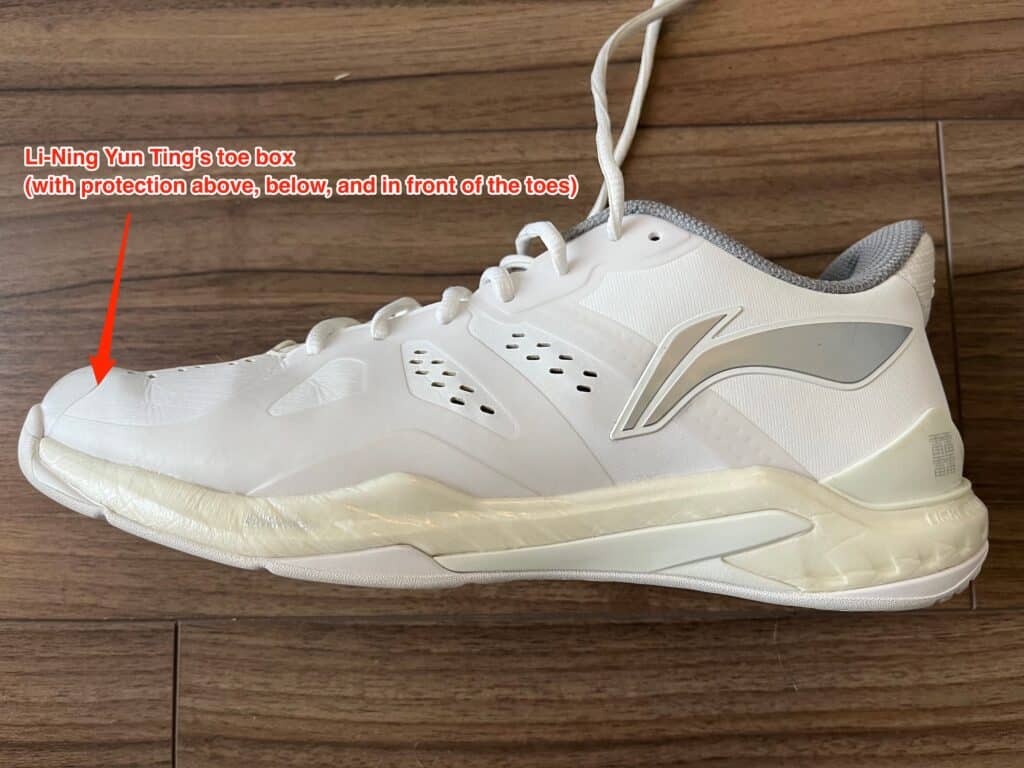
I haven’t found it particularly useful to have superior protection above my toes in exchange for the extra heat it causes. On the other hand, I have yet to meet a player who didn’t want any cushioning at the front of the toe box, which is where the Yonex Eclipsion Z3 has the best I’ve tested thus far.
Despite that, I like extra padding underneath the big toe to avoid soreness and this is where Li-Ning’s Yun Ting 01 has won me over, even if it doesn’t have as much padding at the very front (it’s close though).
The bouncy midsole of love
Next is another area that’s easy to notice: the midsole.
It contributes to soft landings after lunges and jumps, but can also make a noticeable difference during smaller steps. You might not notice the difference during the heat of a duel, but you certainly will when you stop to catch your break or rest between games.
Lightweight performance-based models, and even some all-around ones, can make your feet feel tired and sore after playing. Here, supportive or cushioned shoes can make a major difference and often feel more bouncy, springy, and soft.
Victor’s P9200III with its new drop-in midsole concept offers the most comfortable midsole cushioning I’ve experienced during my tests and reviews of badminton shoes. Naturally, that’s my top pick.
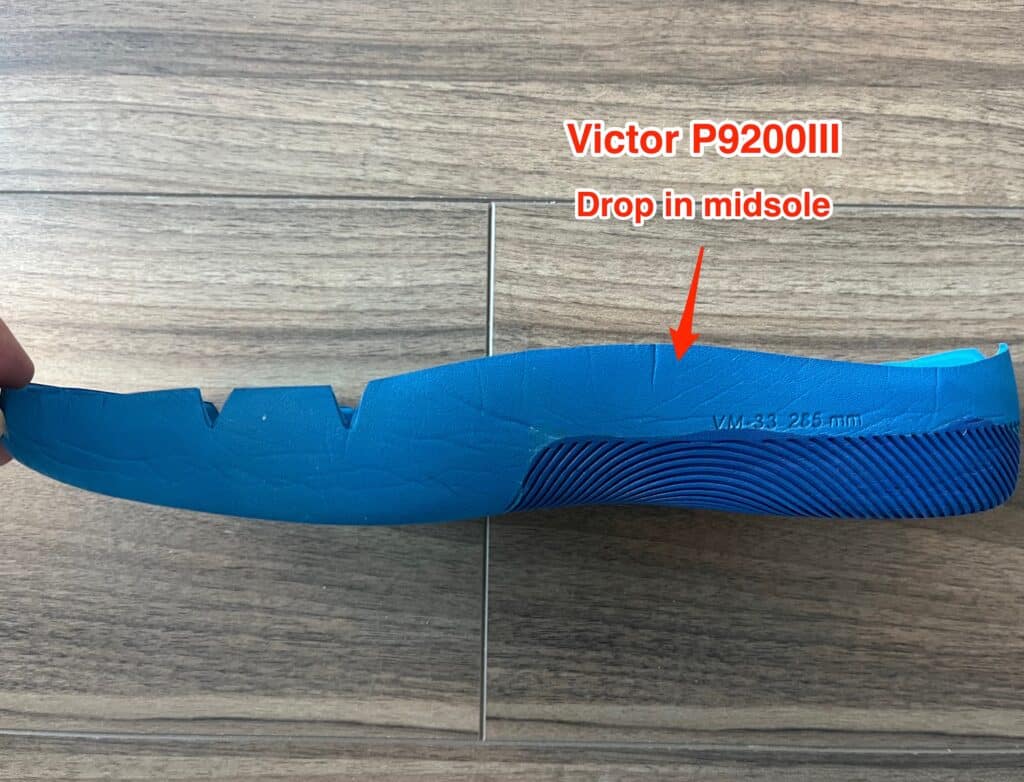
Since the drop-in midsole is combining the midsole and insole, there’s no point in discussing an extra insole. The drop-in sole feels so grippy against my socks that it can be slightly challenging to get the shoes on, but when they’re on, you’re locked in.
The outsole + grip
It’s in the outer grip that I’ve noticed the most similarity between the top brands and their flagship models. I prefer Yonex’s radial blade sole grip that you’ll find on all their current flagship models like the SHB 65z3 or Eclipsion Z3.
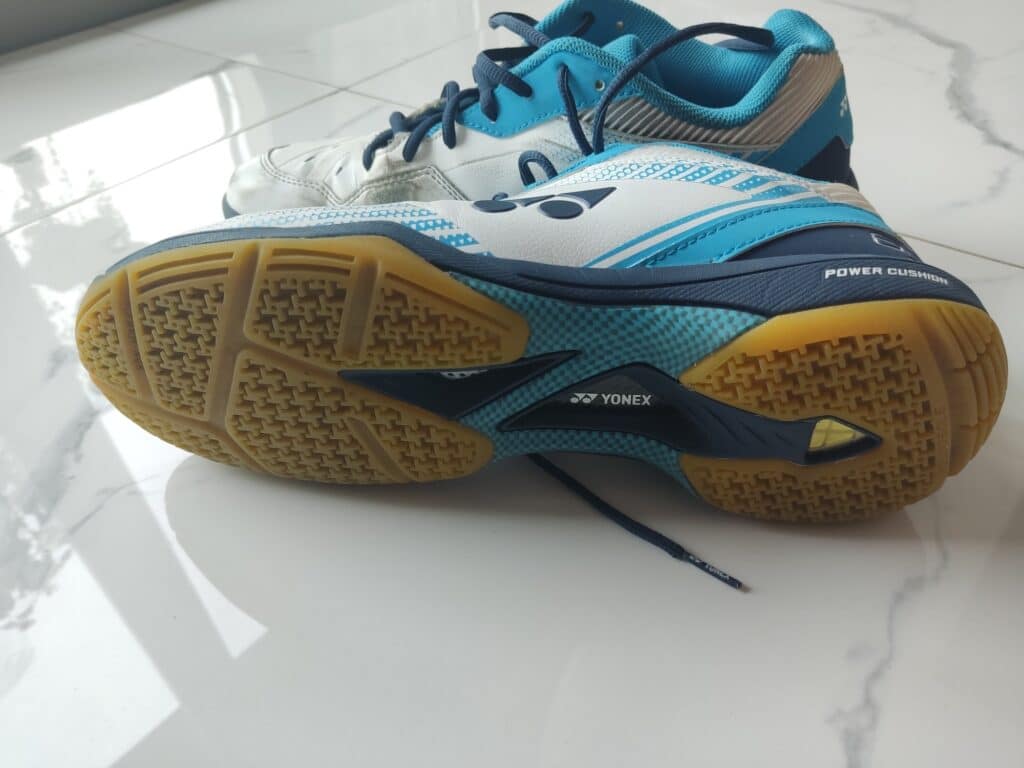
It feels gluey and grippy, but as odd as it sounds I’ve noticed that same grip feeling less effective on certain models such as the Comfort Z3. Since the radial blade sole is the same, it must be the shape of the outsole as that model felt more slippery near the heel compared to other models with the exact same outsole.
If we ignore the grip for a second, I like the stability of the outsole on Yonex’s Eclipsion Z3 as it’s a one-piece made to reduce the shoe flexing between the front half and the back half as you’re twisting and changing directions.

That means the shoe is going to be bulkier and slower in exchange for longevity. A compromise I’ll gladly accept to lower the chance of injuries so I can play more.
Durability and the lunge tear
Most of the shoes I’ve tested have had the same level of durability as expressed with the lunge tear (the lunge tear happens on your non-racket foot during lunges as the side of the shoe grinds against the floor). They’re generally durable and last about the same.
All, except Victor’s P9200III.
Their V-Tough technology appears to be holding up exceptionally well and I can’t even see a dent being made at the lunge tear area after nearly 20 hours on court (for reference, this became noticeable in other models after about five hours of playtime on an indoor court, although without any issues or tear.)
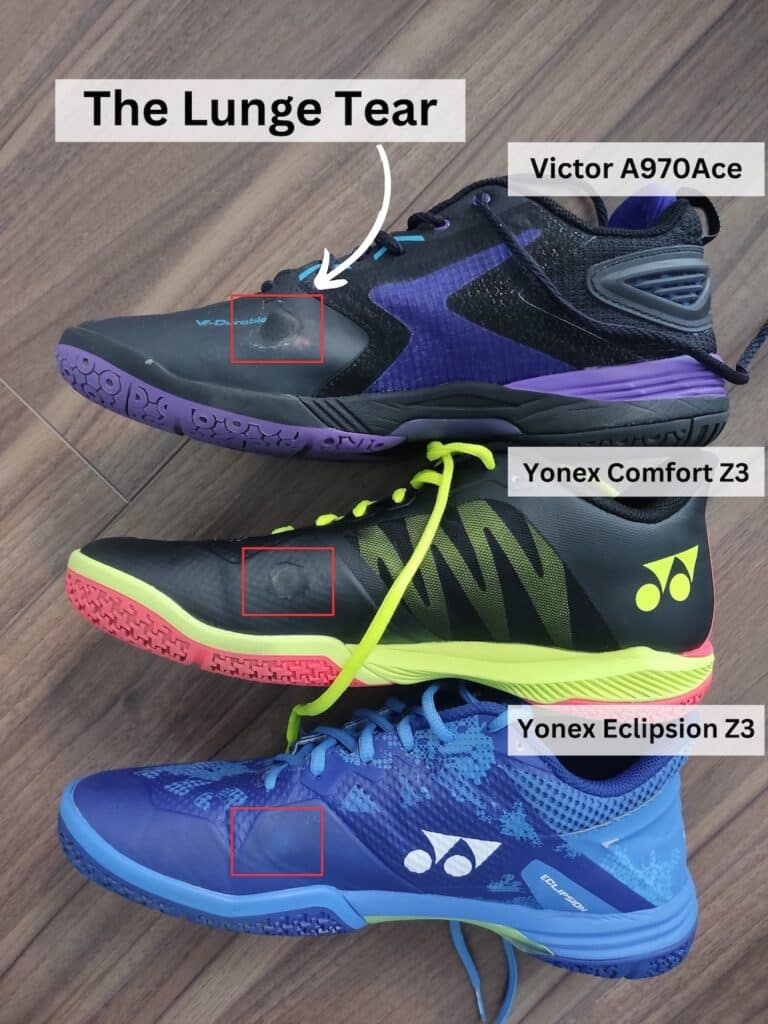

Putting it all together
There you have it: the perfect badminton shoe blending being good all-around with extra support for us recreational players looking for injury protection to play longer.
Let’s revisit the illustration from earlier, but with all the winning parts.
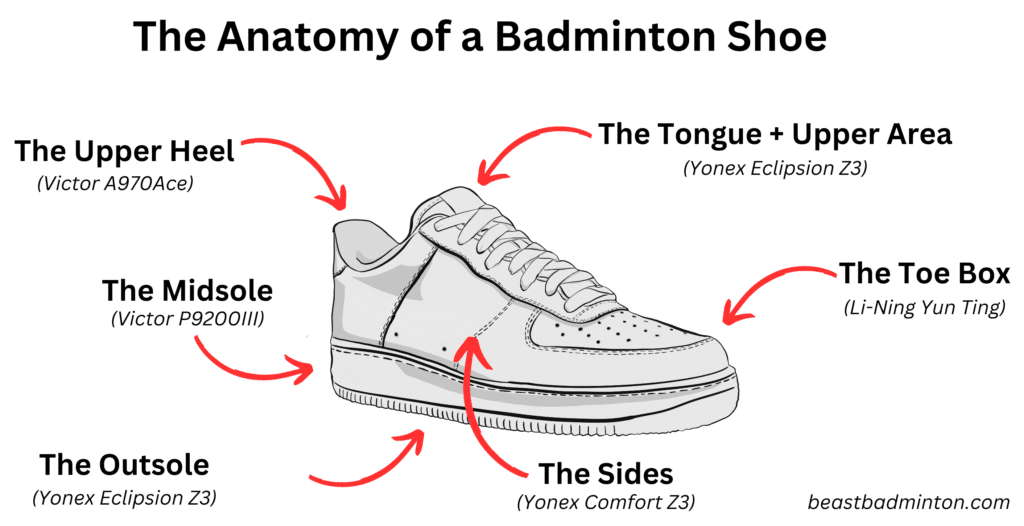
Next, I’d like to hear from you. What’s the most important thing for you when looking for badminton shoes? (Leave a comment below)